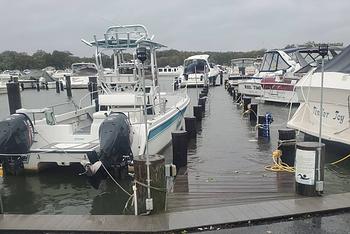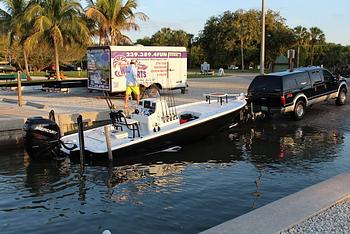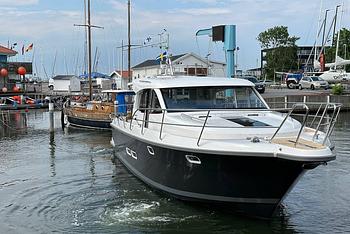When the boating season draws to a close, many boat owners ask themselves: do I need to winterize my boat? This is an important question, because freeze-damage can cause extensive and even catastrophic problems. It can burst pipes in plumbing systems, crack engine parts, and split apart fiberglass. Fortunately, you’ve come to the right place—we’ll lay out the procedures you need to follow and run through a comprehensive “winterize the boat checklist,” so you can rest easy after storing your boat for the season.
Do I Need to Winterize My Boat?
If you live in an area where temperatures may drop below freezing the answer is yes. It’s critical you winterize a boat even if you live in an area with mild winters where sub-freezing temperatures are the exception rather than the norm. That said, a lot depends on the nature of your boat. For small boats that are very simple and have few systems, winterizing it can mean putting on a cover and taking care of the motor. For big luxury center console boats over 40 feet, on the other hand, you’ll have a large number of tanks, pumps, and pipes to handle. So recognize that while all boat owners need to winterize a boat if they live in a climate that’s not tropical, just what it means to do so can be very different from one boat to another.

Some boaters wait until the last minute to winterize – and some wait just a bit too long.
When Should I Winterize My Boat?
Most boaters winterize their boat when they believe the last trip of the season is behind them. However, some people who live in areas with a mild climate will wait to see if and when freezing weather comes along, so they can get in another adventure or two should the weather remain nicer than expected. Either way, the important thing is to pay attention to the forecast and if there’s a freeze predicted, have the boat winterized before it happens.
6 Steps to Winterize a Boat
Remember, every boat is different and the winterization process can vary quite a bit from one to another. That said, here are the critical steps most boats have in common:
- Winterize the engine(s)
- Winterize the plumbing systems
- Winterize any pumps or compartments that may hold water
- Remove the batteries
- Treat the fuel
- Cover the boat
Winterize the engine(s)
Winterizing a boat engine is absolutely critical and is generally considered to be the most important element of winterizing a boat. You can refer to our checklist below but this is important enough that we’ve dedicated an entire article to just this topic: How to Winterize a Boat Motor a Step By Step Guide.
Be sure to read this article in its entirety, because the process is different depending on what type of power system your boat has. Winterizing an outboard engine is very different from winterizing an inboard engine, and the specific actions you’ll need to take can also vary depending on the engine’s manufacturer and model.
Why is winterizing a boat motor such a big deal? Because if water freezes in the engine it can cause tremendous damage or even destroy it. Also remember that a big part of winterization entails keeping a maintenance schedule, including changing the engine’s fluids. Oil can have acid buildup over time, so you always want fresh oil in your engine over the winter months. If you fail to winterize the engine and thus miss regular maintenance chores like this, you may also be inviting long term engine damage.
This part of the job is so important that if there are any doubts in your mind as to whether you can handle winterizing the engine, you should have a professional do the job.
Winterize the plumbing systems
Winterizing the plumbing system in a boat is similar to winterizing one in a summer home. You’ll need to drain the water out of the system, then add non-toxic antifreeze. Start by opening the faucet farthest from the water tank and let it run until completely drained. Then open each in turn working your way back towards the tank. When the system has run dry, add antifreeze to the tank and run it through the system, shutting off the faucets only after antifreeze has begun coming out. If your boat has a hot water heater, be sure to turn it off before draining the tanks down.
You’ll also need to pump out the boat’s holding tank, then add some antifreeze to be sure any liquid left in the bottom doesn’t freeze. Then be sure to flush the head until antifreeze runs through the lines. If your boat has a self-contained head (a portable marine sanitation device, or MSD), remove it from the boat and properly dispose of any waste in its holding tank, then drain the freshwater reservoir.
Following this process is critical, or you may start the spring with burst pipes and mystery leaks. Just remember that come spring you’ll need to de-winterize the plumbing systems by reversing the process with freshwater before you can use them again.
Winterize pumps or compartments that may hold water
Livewell pumps, washdown pumps, fishbox macerators, and any other accessories that may have water in their lines or in the pump itself need to be drained and given a dose of antifreeze. In cases where a raw water intake feeds the system, you can remove the intake line at the seacock, submerge it into a five-gallon bucket full of antifreeze, and activate the pump to get the liquid running through. If the pump can’t pull a prime, hold the end of the intake up higher than the pump and pour in some antifreeze to get it started.
Drains should also be checked, as some of their lines could be holding water. And remember, anywhere water collects, freeze damage becomes a possibility. These can be blown out with compressed air, then you can pour antifreeze directly into the drain.

Compartments that hold water, like livewells, must be fully drained and the pumps and lines given a dose of antifreeze.
Remove the batteries
Batteries should be disconnected and removed from the boat. Put them on a trickle-charger or battery maintainer for the off-season. This is also a good time to clean up any dirty or corroded connections.
Treat the fuel
Fill the boat’s fuel tanks to about 90 percent, to prevent the condensation from forming while allowing enough room for expansion without fuel coming out through the vent. Since the boat will likely be sitting for an extended period of time, you’ll also want to add fuel stabilizer to the tank. This is especially important if your boat is gas-powered and there’s ethanol in the fuel. Note: do this before winterizing the engines, so the stabilized fuel is run through the entire fuel system as well as being in the tank itself.
Since the introduction of ethanol to the fuel supply, treating a boat’s fuel before winter sets in has become more important than ever. Otherwise it can go through “phase separation” and build up a layer of water. Then when you launch the boat in spring, you might end up needing a tow home because water in the fuel will shut you down cold. Even when you fill up with ethanol-free fuel water contamination and fuel deterioration can be problematic, so be sure to dose the tank with those additives.
Cover the boat
Your main mission here is to keep out water so it doesn’t creep into compartments, cracks, and crevices where it can cause freeze damage. A good cover will also keep out the dirt and leaves. But you need to make sure it can vent properly or mold and mildew will form. Standard hardware-store tarps are terrible for this use—it’s best to have a custom canvas cover made for your boat, or have the boat shrink-wrapped by a professional who knows where to add vents and how many to use.
Covers should fit tightly and be secured to prevent flapping in the wind.
Winterize a Boat Checklist
OK, we’ve covered all the bases for how to winterize a boat. You’ve asked how long does it take to winterize a boat, considered the cost to winterize, and thought about when to do it. Now, let’s boil the process down to a handy winterizing checklist.
- Motors
- Winterize the engine(s), using the owner’s manual as a reference or paying a professional who’s familiar with your specific power system and its needs.
- Oil and filters have been changed
- Old oil has been visually inspected
- Outboards are tilted down and covered
- Inboard cooling system(s) have been winterized
- Engine has been fogged as per manufacturer’s instructions
- Plumbing System
- Freshwater systems including tanks and lines have been drained
- Freshwater systems including tanks and lines have received antifreeze
- Portable heads have been removed and drained
- The head and/or waste tank has been drained
- The head and/or waste tank has received antifreeze
- Pumps or Compartments
- Any and all pumps and their lines have been drained
- Any and all pumps have and received antifreeze
- Any compartments with drains have been blown out and received antifreeze
- Batteries
- Remove them from the boat
- Put the batteries on a trickle charger
- Clean any dirty or corroded terminals
- Fuel
- Fuel tanks have been filled to approximately 90 percent
- Fuel tank has been treated with a fuel stabilizer
- Treated fuel has been run through the system
- Covers
- The boat has been covered or shrink-wrapped
- Proper ventilation has been ensured
- The cover is secure and won’t flap or saw back and forth in the wind
Winterizing a boat may seem like a complex process, but in truth it’s only as complex—or as simple—as the boat and its systems. But we do have one final word of advice: regardless of what size or type of boat you’re winterizing, it’s wise to take the time to give it a thorough cleaning and a thick coat of protective paste wax before you put it away for the winter (see 3 Simple Ways to Keep Your Boat Looking Good as New). That way, not only will your boat be ready for action as soon as spring returns, it will look sharp, too.
Fail to assure proper ventilation, and mold and mildew will set in. This leaning post cushion was ruined, as a result.
FAQs
How much does it cost to winterize a boat?
There is no one-size-fits-all answer to this question. Obviously, size matters. But it also depends on the complexity of your boat’s systems and whether you pay a professional to do the job or you spend your own time on it. We can, however, offer a few case-studies to help you get some idea of the burden to bear in case you’re scratching your head, asking yourself “how much does it cost to winterize a boat?”
With a small skiff with no additional systems other than an outboard motor, you need only pay for motor oil, filters, and a cover. Figure on spending a few hundred dollars, maybe a bit more if you buy a custom cover (but then you won’t have to pay for shrink-wrapping in the future). On a midsized boat like a 28-foot pocket cruiser, you’re likely to spend $1,000 or so between supplies and a shrink-wrap job, and custom covers can cost several thousand dollars. Pay to have it done by a pro, and cost will climb by 50 or so percent. On larger boats and yachts the job is generally left to professionals and will run into the thousands of dollars.
How long does it take to winterize a boat?
Again, this all depends on the size and nature of the vessel. That little skiff won’t take more than a few hours, but the midsized boat will require a full day’s work. And the bigger the boat is the more work that’s involved, so in some cases the process can take several days.
What happens if I don’t winterize my boat?
Boats that aren’t winterized are likely to suffer from freeze damage of one sort or another. Even if they don’t, exposure to the winter weather generally takes a significant toll on the boat in a number of ways.
Can I use my boat after it’s been winterized?
Maybe. The answer to this question depends on whether the boat is covered or shrink wrapped, and the type of power system it has. Covers can be removed then put back on easily enough but shrink wrap can’t be replaced once you take it off of the boat. So if your boat is shrink wrapped, waiting until spring is generally the best move.
If the power system is an outboard you can run the engine at any time then tilt it down to drain it and re-fog it, so many outboard owners do use their boats if there’s a break in the winter weather. In the case of inboard power systems, which require a much more involved process, you probably won’t want to go through all the effort just to use the boat once or twice.
Note that even if you have a cover and an outboard and decide to make the best of a winter warming trend, you still won’t be able to use accessories like those depending upon the plumbing systems. Also, you will have to be sure all pumps that may pick up water (such as livewell or washdown pumps) are drained again.
Can I winterize my boat in the water?
Yes, but generally only work boats and large boats which would be prohibitively expensive to haul and block are left in the water through the winter. After winterization, these may have bubblers installed around the hull to prevent water from freezing up against the boat. However, as a general rule of thumb it’s always best to remove a boat from the water for winter if at all practical.

When the snow starts falling, boats that are properly winterized will be fine but those that aren’t may suffer from all sorts of damage.
This article was published in October 2023 and updated in December 2024.





